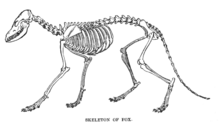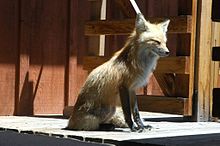12 species belong to the Vulpes genus of "true foxes". Approximately another 25 current or extinct species are always or sometimes called foxes. Foxes are found on every continent except Antarctica. By far the most common and widespread species of fox is the red fox (Vulpes vulpes). The global distribution of foxes, together with their widespread reputation for cunning, has contributed to their prominence in popular culture and folklore in many societies around the world. The hunting of foxes with packs of hounds, long an established pursuit in Europe, especially the British Isles, was exported by European settlers to various parts of the New World.

Etymology
The word fox comes from Old English, which derived from Proto-Germanic *fuhsaz.[2] This in turn derives from Proto-Indo-European *puḱ- ‘thick-haired; tail’.[3] Male foxes are known as dogs, tods or reynards, females as vixens, and young as cubs, pups, or kits. A group of foxes is referred to as a skulk, leash, troop, or earth.[citation needed]General characteristics
In the wild, the typical lifespan of a fox is 2 to 3 years, although individuals may live up to ten years. Foxes are generally smaller than other members of the family Canidae such as wolves, jackals, and domestic dogs. Male foxes weigh, on average, around 5.9 kilograms (13 lb) while female foxes weigh around 5.2 kilograms (11.5 lb).[4] Fox-like features typically include a triangular face, pointed ears, a long, narrow, sharp muzzle, and a bushy tail. Other physical characteristics vary according to habitat. For example, the fennec fox (and other species of fox adapted to life in the desert, such as the kit fox) has large ears and short fur, whereas the Arctic fox has tiny ears and thick, insulating fur. The red fox, by contrast, has a typical auburn pelt, the tail normally ending with white marking. Litter sizes can vary greatly according to species and environment – the Arctic fox, for example, has an average litter of four to five, with eleven as maximum.[5]Unlike many canids, foxes are not always pack animals. Typically, they live in small family groups, and are opportunistic feeders that hunt live prey (especially rodents). Using a pouncing technique practiced from an early age, they are usually able to kill their prey quickly. Foxes also gather a wide variety of other foods ranging from grasshoppers to fruit and berries. The gray fox is one of only two canine species known to climb trees; the other is the raccoon dog.
Foxes are normally extremely wary of humans and are not usually kept as indoor pets; however, the silver fox was successfully domesticated in Russia after a 45-year selective breeding program. This selective breeding also resulted in physical and behavioral traits appearing that are frequently seen in domestic cats, dogs, and other animals, such as pigmentation changes, floppy ears, and curly tails.[6]
Classification
Canids commonly known as foxes include members of the following genera:- Alopex: Former genus of the Arctic fox, now considered part of Vulpes.
- Canis: Ethiopian wolf, sometimes called the Semien fox or Semien jackal.
- Cerdocyon: Crab-eating fox.
- Dusicyon: Extinct genus, including the Falkland Islands wolf, sometimes known as the Falklands Islands fox.
- Lycalopex: Six South American species.
- Otocyon: Bat-eared fox.
- Urocyon: Gray fox, island fox and Cozumel fox (undescribed).
- Vulpes: Includes 12 species of true foxes, including the red fox, V. vulpes, Tibetan sand fox, V. ferrilata and their closest kin.
-
The fennec fox is the smallest species of fox.
-
Arctic fox curled up in snow.
-
-
Crab-eating fox, a South American species.
-
Diet
Foxes are omnivores.[7][8] The diet of foxes is largely made up of invertebrates such as insects, and small vertebrates such as reptiles and birds, and also can include eggs and plants. Many species are generalist predators, but some (such as the crab-eating fox) have more specialized diets. Most species of fox consume around 1 kg (2.2 lb) of food every day. Foxes cache excess food, burying it for later consumption, usually under leaves, snow, or soil.Conservation
Many foxes adapt well to human environments, with several species classified as "resident urban carnivores" for their ability to sustain populations entirely within urban boundaries.[9] Litter size in urban areas can be smaller than in non-urban areas, but urban foxes can be longer-lived than their non-urban counterparts.[9] Urban foxes are ubiquitous in Europe, where they show altered behaviors compared to non-urban foxes, including increased density, smaller territory, and pack foraging.[10]Foxes have been introduced in numerous locations, with varying effects on indigenous flora and fauna.[11] Red foxes were introduced into Australia in the early 19th century for sport, and have since become widespread through much of the country. Their impact on native vegetation and animals is subject to much speculation.[11]
Several fox species are endangered in their native environments. Pressures placed on foxes include being hunted for pelts, other trade, or control.[12] Due in part to their opportunistic hunting style and industriousness, foxes are commonly resented as nuisance animals.[13] On the other hand, foxes, while often considered pests themselves, have been successfully employed to control pests on fruit farms while leaving the fruit intact.[14]
Relationships with humans
Foxes are often considered pests or nuisance creatures for their opportunistic attacks on poultry and other small livestock. Fox attacks on humans are not common but have increased in frequency.[15]Fox hunting
Main article: Fox hunting
Fox hunting originated in the United Kingdom in the 16th century. Hunting with dogs is now banned in the United Kingdom,[16][17][18][19]
though hunting without dogs is still permitted. It is practiced as
recreation in several other countries including Australia, Canada,
France, Ireland, Italy, Russia and the United States.Domestication
See also: Domesticated silver fox and Red fox § Taming and domestication
There are many records of domesticated red foxes and others, but rarely of sustained domestication. A recent and notable case is the Russian silver fox,[20]
which resulted in visible and behavioral changes, and is a case study
of an animal population modeling according to human domestication needs.
The current group of domesticated silver foxes are the result of nearly
fifty years of experiments in the Soviet Union and Russia to
domesticate the silver morph of the red fox. Notably, the new foxes
became more tame, allowing themselves to be petted, whimpering to get
attention and sniffing and licking their caretakers.[21]In culture
Main article: Foxes in culture
In many cultures, the fox appears in folklore as a symbol of cunning and trickery, or as a familiar animal possessed of magic powers.In some countries, foxes are major predators of rabbits and hens. Population oscillations of these two species were the first nonlinear oscillation studied, and led to the now-famous Lotka-Volterra equation.[22][23]










No comments:
Post a Comment
Note: Only a member of this blog may post a comment.